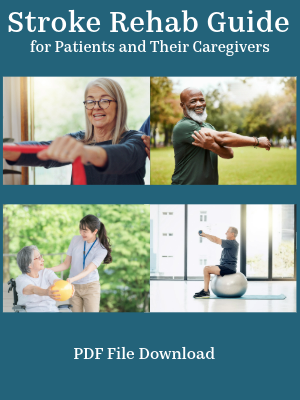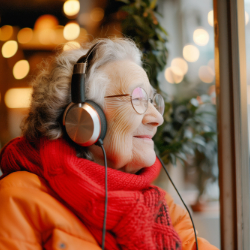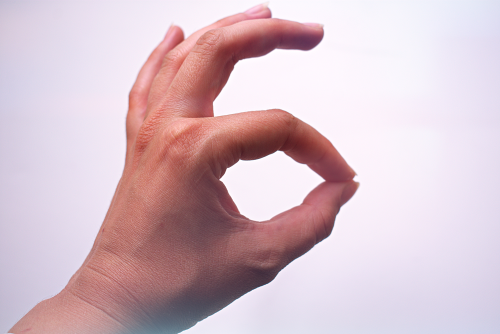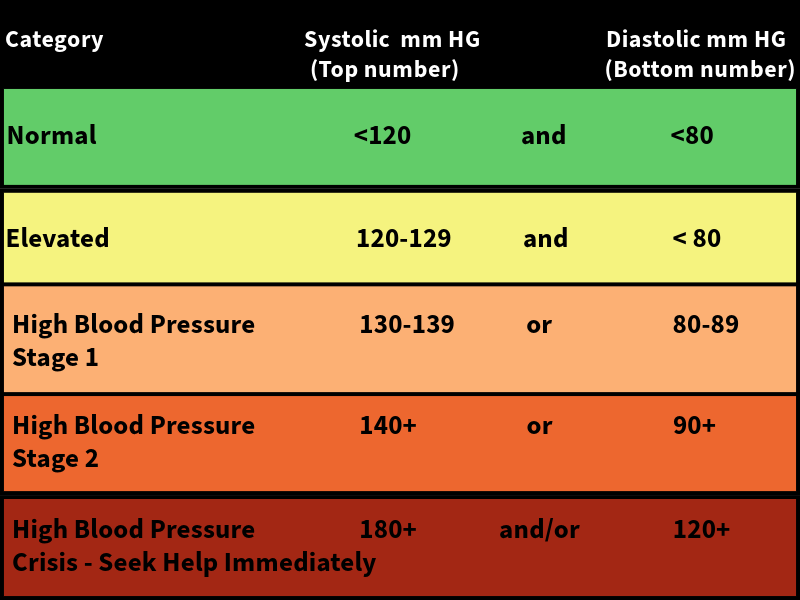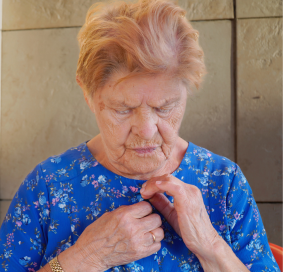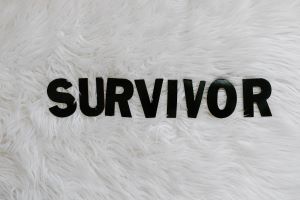Submissions from Readers
Hemiplegic Hand
by Andy R.
(Wheeling, WV.)
Question: I'm 2 years post stroke with left side hemiplegia. I still have no movement or feeling in the left hand. Should I give up and accept it?
Answer: I would never tell anyone to give up and accept it. Research over the past ten years has shown that the brain has neuroplastic properties and has the potential to "rewire" itself to help overcome some of the deficits caused by stroke. There have been studies where stroke victims have progressed even years after having their stroke.
I think the problem for most people is that neuroplastic change requires repetition and practice. If someone has no movement or feeling, then they will need help from others, robotic aids, and/or electrical stimulation to assist with rehabilitation of the hemiplegic limb. They will also need a lot of motivation and time to work on rehabilitation. Many people don't have someone that has the time to help them or the resources to afford long term therapy.
The therapy that a patient receives immediately post stroke often focuses on relearning daily activities using compensation techniques, learning to balance oneself, transferring from one surface to another, and learning to take steps. Even when stroke patients are taught to walk again, they are often given a hemi-walker, and they learn to rely on the strong side for support. This doesn't help the weak side regain movement but rather teaches the patient to compensate. Compensation is not a bad thing - it allows many people to function that otherwise couldn't. However, it also "rewires" the brain to function in that compensation mode resulting in underutilization or complete neglect of the side affected by stroke. This is especially true for the hemiplegic arm or hand. Once stroke patients are discharged to outpatient therapy or home health, they are only receiving 2 or 3 treatment sessions per week for approximately 1 hour from each discipline. That is not enough for neuroplastic change to the brain. Once discharged from therapy, many patients perform activities and exercises even less.
I think you should find a therapist that is highly experienced in working with the hemiplegic hand/arm and that has a good track record with results. If you have exhausted your insurance and therapy is not an option, try getting into clinical trials where you can receive free treatment. Make sure you know the risks of any clinical trial you apply for.
Some exercises that I use for hemiplegic hands include:
1. Gentle stretch to the fingers opening the hand and bending the wrist back as well as gently stretching the thumb to the side.
2. Tapping the muscles of the back of the forearm to facilitate fingers opening and raising the hand up. Tap the muscles on the underside of the forearm to facilitate making a fist.
3. Placing the open hand on a soccer ball and trying to maintain it on the ball without falling off.
4. If you can maintain the hand on the ball, try to roll it slightly side to side and forward and back without the hand falling off.
5. If you can maintain the hand on the ball, attempt to then place the hand on the side of the ball and hold the ball with both hands without the weak hand falling off. Bring the ball to your chin and back to your knees using the strong hand as an assist.
6. Try to use your fingers to drag cards off of the table into your other hand.
7. Try to place your hand around the top of a cane and push/pull the cane without the hand falling off.
The above activities are simple placing activities of the hand on an object with the arm actually producing the movement rather than the hand. This is important because being able to place the hand on an object without it falling off is the first step to being able to use the hand in my opinion. If you can place the hand on objects without it falling off, then you can use that arm for stabilizing. Then you can move on to trying to facilitate movement and holding larger then smaller objects inside the hand. I'm assuming you have some arm movement since you mentioned only your hand not moving. I would definitely keep working and look for a therapist that is passionate about working with stroke and arm recovery. Therapists only receive basic training in school so you need to find someone that has gone on to do self study or continuing education in stroke recovery.
Also, keep on top of stroke news as you never know what new techniques or treatments will emerge that can allow for you to regain some hand use. If you don't have access to a therapist, you can try searching You Tube videos for hand rehabilitaton ideas following stroke. There are therapy schools, therapists, and stroke survivors who have posted videos showing the techniques they have used to regain hand function. It might give you some ideas to try.
Hand exercise machine?
by Matthew
(London UK)
Question: Hello, thanks for your website. It has been eighteen months since my stroke, at age 50 years, which left my left arm and leg without movement. I have managed to learn to walk (slowly). but still have almost no movement in my left arm. I am wondering if you know if there is available any contraption that actually moves the hand and fingers, so that as well as muscle stimulation, the brain sees the hand moving. I am not interested in electrical stimulation. Thanks for you attention.
Matthew
Answer: The only devices I know that cause muscle contraction would involve electrical stimulation. Any movement that occurs without muscle contraction or electrical stimulation would be considered passive so there wouldn't actually be active muscle contraction.
There is a device called the Hand Mentor that helps move the hand/wrist. The Hand Mentor encourages self-initiated motion in the wrist and fingers, and assists movement only when necessary. You can read about it at http://www.kineticmuscles.com/hand-physical-therapy-hand-mentor.html.
Mirror box therapy can be used to "trick" the brain into thinking the affected hand is moving. In mirror therapy, the reflection of movements of the stronger hand and arm are watched in the mirror. You can visit some of the following to find out more about mirror box therapy:
http://strokengine.ca/intervention/index.php?page=topic&subpage=patient&id=49#section2
https://www.youtube.com/watch?v=FR6Q4Z0GXK0
https://www.youtube.com/watch?v=hMBA15Hu35M
Mirror boxes can be bought or made from home.
Comments for Hand exercise machine?
|
||
|
||
|
||
Hand Flaccidity
by Monu
(Bangalore)
Question: What are the latest techniques used to treat flaccid hand?
Answer: The newer techniques for treating a flaccid hand (in the last 10 years) would include various robotic devices. Some of the devices move the hand passively, others use electrical stimulation, and others rely on any volitional movement the hand may have on its own. Some of the websites you can visit regarding these devices include:
www.bioness.com
www.saebo.com
www.kineticmuscles.com
www.interactive-motion.com/
www.tyromotion.com
Some other techniques used include mental imagery and mirror box therapy.
If you are looking for information on the effectiveness of various techniques for arm and hand rehabilitation after stroke, there is a website that provides a review of the various studies. You can find it at: www.ebrsr.com. There is a lot of technical jargon, but if you read the summary portion of the findings, it should provide some useful information.
Comments for Hand Flaccidity
|
||
|
||
Stroke Left Hemi with Brunnstrom Stage Four
by Sabrina Talton
(Macon, GA)
Question: Could a left hemi with Brunnstrom stage 4 use a hemi walker using a dynamic SaeboFlex splint in order to ambulate or use the splint to help in washing clothes?
Answer: The only way to know for sure is to try the SaeboFlex. I am a little confused on the first part of your question because a hemi walker is normally used by the non affected hand to ambulate not the side with hemiparesis. The Saebo.com website has a tab for patients that has a video showing the movements needed to use their product. If the patient has the movements needed, the Saebo may be able to help them with doing laundry, but the only way to know for sure is to try it.
Hand
by Tino Cote
(Twin Lakes,WI,USA)
Question: Hi, I'm a 26 year old man and I had a stroke back in December of 2008, and I just can't remember how to open my hand. Any suggestions?
Answer: Take the working hand and slip it under the knuckles of the paralyzed hand. Place pressure on the back of the knuckles with the good thumb and lift the fingers with your good hand. Place the paralyzed hand on a flat surface and put weight down through the hand which should relax the hand. Once you have relaxed the hand, you can try to open it on its own volition. If the hand tightens back up, repeat the procedure above. If you get no movement, you can try tapping the back of the forearm to facilitate movement. Another option if you are a candidate is electrical stimulation or Bioness. Visit your MD or ask for a therapy referral to see if you are a candidate for e-stim as some patients cannot use it.
Over All Work
(Anonymous)
Question:I don't have any exercises. Could I get some for arm / hand and walking. My hand is not moving. Only about 98% for the arm/hand doesn't move and 30% for the leg does not move. This is all on the right side.
Answer: Please see the answers above regarding arm/hand exercises.
Hand and Arm Exercises for Stroke Recovery?
by Karon Carpenter
(Boise ID)
Question: I left the hospital a year and a half ago, and my left arm and hand are still non operational. I am only 42 and all the therapists and doctors were convinced it should only be a year before I regained use as "you're so young" they all said. I was kicked out of rehab due to insurance cancelling me now new insurance won't cover due to "pre-existing" condition. I am moving somewhere with a pool and hottub and was going to kick the exercising in high gear. I figured passive range of motion exercises with assist in the pool would help. I also need help with the weight bearing as my elbow bends and I can't hold the hand and straighten elbow with one free hand. Is there a site or a book I can refer to? Please advise as I'm ready to be better and kick this stroke's butt!
Answer: To hold the hand in place for weight bearing, one can try dycem which is a synthetic material that won't allow the hand to slide off of the weight bearing surface. The pic below shows dycem.

Similar no-slip materials can be found at major retail chains like Walmart or Target around the kitchen supplies section at a much cheaper price.
There is a special flat paddle with straps that can help open the hand. These paddles can be purchased at http://www.kinemedic.com/therapyaidssemicustomorthotics.htm. You have to scroll down that page to find the flat hand paddle with straps (there are several).
An Urias air splint can be used to hold the elbow straight during weight bearing. I only use the air splint during weight bearing exercises as it is not meant to be a device for for use over a prolonged time period (it should not be used more than an hour and one should always check for skin issues when using it). These air splints can be found at various online medical supply sites such as http://www.rehaboutlet.com/pressure_splints.htm.
One should check with their physician or occupational or physical therapist to make sure any of the above devices are appropriate for their situation and that there are no medical conditions that would preclude one from using them.
cone for keeping hand open during the night
Question My late husband had a plastic cone with a terry cloth cover that we put on his affected hand to keep his fingers away from his palm. It was about 6" long and maybe 2 inches across at the large end. There was a strap with velcro that went across his knuckles to keep it in place.
It was easy and did not disturb his sleep like some of the larger splints.
I would like to order one of these for a friend's mom, but I can't find it in a couple of catalogs that I've looked at so far.
Can you help?
thanks,
Maggie Ray
Answer: You can do a search for hand contracture cone on google images to find the one you are looking for or maybe try these websites:
http://www.abledata.com/abledata.cfm?pageid=19327&ksectionid=19327&top=11845
http://www.vitacaremedical.com/product.php?id_category=18&id_subcategory=50
http://www.advantageplusmedicalsupplies.com/Splints-Contracture/Plastic-Hand-Cone.html
Nail Issues in the Hemiplegic Side After Stroke.
by Betty
(Texas)
Question: My 87 year old mother had a severe stroke 10 months ago that left her completely paralyzed on her left side. She experiences a lot of pain in both the left arm and leg. This week she has developed a break down (not a pressure spot) just below the thumb on her left hand and the thumb nail is turning black as well as one of the toe nails on her left foot. The doctor says this is from lack of circulation. Can you explain to me what is happening and what I can expect as this progresses.
Answer: This is a question for a MD who deals with vascular problems. It is definitely not the norm for the nails to turn black after a stroke, but it is not uncommon for a person who has had a stroke to also suffer from peripheral vascular disorders or neuropathy. She definitely needs to be checked out and assessed for treatment options if her nails are turning black and especially if skin breakdown is present. If circulation is an issue, then keep the feet elevated, and when sitting, elevate the arm as well.
Delay hand tremor after stroke
by Kate Truong
(Sydney)
Question: Hello, my mum had a stroke last year when she was 60 yrs and her left side was affected. However, she has been recovering very well. She can walk, do housework, eat, talk almost as before. But these days, her left hand has started shaking a bit and we are so worried about that. Is that normal with a stroke sufferer and what can we do? Her left leg is still numb, not fully recovery yet. I want to buy her a foot massage machine. Just wondering if it is good for her.
Looking forward to hearing your advice
Thank you.
Kate
Answer: Tremors can result from stroke, but since the hand tremor is just now showing up, I would have your mom see a neurologist to determine the cause. Hand tremors can be caused by various factors and can be harmless or may be indicative of neurological problems.
A foot massage machine should be fine as long as your mother's skin is intact without sores. If she has decreased sensation on her feet, I would monitor the use of the massager to make sure the pressure is not too forceful.
problem with index finger on left hand
by Kathy Joyce
(London, UK)
Question: I had a minor stroke about 7 weeks ago, leaving my left arm and hand weak. Although I am making great recovery with the left hand, my index finger bends inwards when trying to pick up larger objects. I also have problems releasing grip. Any ideas on how I can help myself with this problem? Kathy
Answer: I can't really recommend specific exercises without examining someone, but it sounds like you need to work on finger extension. You could lay the hand down on the table and try lifting the fingers off the table. I would actually practice picking up and letting go of objects of different sizes starting with skinny cups and working up to larger cups. You could also ask your therapist if e-stim was an option for you. There's a program called GRASP which has some exercises you could try. It can be found at http://neurorehab.med.ubc.ca/grasp-downloads-2/grasp-patient-books-2/. . You could download manual 3 and try the exercises toward the end of the manual (though all the exercises in the manual are good).
Fidgety Hands after stroke
Question: My mom had a stroke 2 months ago. So when she is laying in the bed she has fidgety hands. She is always picking at her sheets or the buttons that raise or lower her bed. I was wondering if you could suggest something I could give her to hold to would keep he satisfied and help with her recovery at the same time.
Answer: You could try hand exercise equipment which could be found on websites like www.ActiveForever.com or www.Pattersonmedical.com. You could also look into objects that teachers and therapists use with kids (and adults) that are fidgety. A good place to find these fidgety hand items is at http://www.therapyshoppe.com/category/8-fidget-toys . I highly recommend looking at these items.
squeezing ball
Question: Some people say squeezing a ball is good for your hand and arm after stroke. Other therapists say no. What do you think? Thank you.
Answer: I do not know of a research study that specifically deals with the effect of squeezing a ball after stroke. There may be one, but I do not know of it. I think that some therapists will say not to squeeze a ball because they are scared that you will cause an increase in tone and tightness in your hand that may lead to tendon shortening and contractures. This is because some stroke patients have abnormal tone and their hand tends to curl up but not release without assist. Without research results, it's hard to say if squeezing a ball causes increased tone/contractures, but there are research studies that show resistance training to other muscle groups does not increase spasticity so I do not know if this is true or not with the hand.
In my practice, if someone has a tight hand that will not open well, I do not generally recommend squeezing a ball but rather to work on grasp/release or pinch/release of objects so that muscles on each side of the hand are being worked (the flexors for grasping and the extensors for opening the hand). This is just a basic strengthening principle. You would never tell someone to work only the chest muscles and ignore the back or the chest would become overly tight and the patient would become rounded at the shoulders. It is the same with the hand. If you overwork one side of a joint, it will become tight and shortened so it is important to work both sides.
If I had someone that did not have tightness in the hand or couldn't close the hand, then I would have no qualms with them trying to squeeze a ball to try and get the movement back. I would monitor them for tightness and make sure they are doing exercises to counterbalance tightness. This may involve using e-stim/stretching/strengthening depending on the person's level of movement.
Hand Splinting after stroke
Question: What is the best splinting method to maintain ROM in the wrist and fingers in order to prevent contractures or stiffness? The patient presents with some tone present in the hand.
Answer: According to the Evidenced Based Review of Stroke Rehabilitation (ESBSR), splinting has not shown to effectively reduce spasticity or prevent contractures in the stroke patient population. When looking at most of the reviewed research, it appears they mostly have looked at results that are less than a year (many less than 4 months) so I don't know if this finding still holds true over several years, but it definitely appears to have no advantage in the short term. The best approach is to have the person using the hand and use good positioning when not in use.
It has been hard to understand these research findings as a therapist because splinting in orthopedic conditions has definitely been shown to decrease contractures and contracture formation so I do not know why splinting would not work in the stroke population. I think further research is warranted especially over the long term, but the research reviewed to date has not shown splinting to be effective.
Writing Difficulties After Stroke
by Diana Clayton
(Live Oak, TX USA (near San Antonio))
Question: A mild stroke has occurred with speech impairment only as well as being unable to write legibly. How does brain to hand coordination come about? He is receiving speech therapy and doing well with it. Only minimal physical therapy was needed. Stroke occurred Dec. 17, 2014
Answer: Handwriting can be affected for several reasons. It can be due to impaired vision from a stroke, impaired sensation in the hand, decreased movement or paralysis in the hand, decreased coordination, or can be due to certain forms of aphasia and the inability to write words anymore. If it is truly only a coordination problem, then I would recommend working on in hand manipulation and fine motor skills. A video of in hand manipulation skills can be viewed at: https://www.youtube.com/watch?v=wGdyXpqO7Jo. Fine motor exercises can be viewed at https://www.stroke-rehab.com/hand-exercises.html. I would also have the patient start with making straight lines, then curved lines, circles, and then letters. You could also try mirror therapy where the patient watches the non-affected hand in a mirror tricking the brain into thinking that the affected hand is working normally and thus making neuroplastic changes in the brain.
A thorough eval should be done to make sure that other problems aren't the culprit though. For example, a lack of sensation can appear as a coordination deficit when in fact the problem is that the patient can't tell how much pressure they are putting on an object or if the object is even securely in their hand.
One handed fishing
by Jim King
(Columbus, Ohio)
Question: I only have use of right hand, & grew up fishing. I've completed rehab, its been 22 months since accident.
I found a "stroke victims" fishing rod holder to wear around my waist. But not finding anything online about tying a fishing hook with the fishing line.
Can you please give me some info or sites to look through.
Thanks so much!!
Answer: I cannot attest to the effectiveness of any of the products, but I did find the following links that may help:
http://www.adaptiveoutdoorsman.com/ty01.html
http://www.achievableconcepts.us/usa_fish.htm
http://usdisabledanglers.wix.com/resources#!/cc06
Reaching and Releasing
Question: I would like to thank you for your informative website. I am currently working with a patient who is about 4 months post a stroke. This is his second stroke as he experienced one about a year ago, from which he recovered almost completely from. He currently is having difficulty reaching for items with his left upper extremity. When he reaches, he abducts his shoulder, flexes the elbow and wrist, resulting in inefficient reaching pattern. With difficulty he can then grasp an item, but more notably has significant difficulty releasing his grasp of the item. I would appreciate any insight or suggestions into techniques I can implement to address his deficits.
Answer: When I have patients that have problem releasing, I try several different approaches. One is trying to get them to relax their grip rather than trying to open the hand. Sometimes patients will try to release but instead end up tightening their grip more. I will ask them to just relax and let an item slip out of their hand rather than have them focus on releasing. If patients are appropriate, I will use e-stim to help with releasing. You can also look into some of the Saebo products which help with reach and grasp/release. These can be viewed at www.saebo.com. I have also rigged up ways to support the weight of the arm and let patients work on using the elbow/hand. I have used our pulley system at work or therabands to do this, but you can also use a deltoid assist if you have one of these where you work.
As far as the inefficient reaching pattern, I would not worry about the quality of movement at this point but rather just getting the patient to move. You can work on reaching for items at different heights and different directions to grade the difficulty. You could also have the patient try mirror therapy as an adjunct to possibly assist with neuroplastic changes.
Another suggestion is to incorporate something that the patient really likes or that motivates him to reach or use the arm. I worked with a gentlemen that didn't do well with reaching for random objects, but when we tried to assemble PVC pipes or work on holding a steering wheel and turning, he did very well because these things had interest to him.
Hand Swelling
Question:My fingers are swollen. What do I do about it? It swelled about 4 weeks after my stroke. I've had x-rays and they said there was nothing to see.
Answer: Some things to try would include elevating the hand above the heart when sleeping and sitting, massage therapy or see a lymphedema therapist, kinesiotaping to reduce swelling, a compression glove, a compression glove with a chip bag inserted, and exercising the hand (muscle contractions may help pump out fluid). Your best bet would probably be to see someone trained in lymphedema therapy, and they can show you how to wrap your hand or what techniques to use to control the swelling.
Hand coordination
Question: My mother suffered a mild stroke about 12 months ago and she his now suffering dysfunction in both hands. She cant use cutlery properly or hold a cup of tea without risk of dropping or spilling. Could you please advise if acupuncture is a worthwhile extra tool/therapy, to assist with hand and finger coordination? Thank you. Julie
Answer: According to the Evidenced Based Review of Stroke Rehabilitation (www.ebrsr.com), there is evidence that acupuncture does not improve upper extremity function. Evidence based reviews only include studies that meet certain standards so these are based on better research studies.
I have seen some studies that say it does help, however, I do not know if the studies that showed positive results were done with rigorous methods, and obviously since the EBRSR says that it has not shown to help, then I believe these positive studies may have been excluded due to the way they were organized or were in opposition to most other studies they looked at. If you go to Google Scholar and enter the term acupuncture and fine motor coordination, it will show you various research results. I've had patients that have done acupuncture and gave it glowing reviews though I don't believe any of them did it specifically for the purpose of improving fine motor skills.
Variety of exercises
by Sandra
(Rimrock, AZ)
Question: Had a stroke a month ago. Right side paralyzed. I now can walk but still need strength along with my hand. There are SO many exercises. How do you know which ones to work on. Very confusing.
Answer: I would say that you would want to determine what goals are important to you and work on exercises that help achieve those goals. As you achieve a goal, then you can move on to something different. It is also important to know the cause of your difficulty. For example, if your having trouble with your hand, you have to be more specific as to what is wrong. Is it a sensation issue, increased tone, lack of strength, paralysis, impaired fine motor coordination, swelling, etc. I've seen people who actually didn't have a coordination problem but rather a lack of sensation which made it look like they had a coordination problem. Maybe a certain part of the hand isn't working rather than the whole hand. Maybe tone or swelling is interfering with movement. Sometimes your therapist will give you too many ideas/exercises (I know I'm guilty). In that case, you have to talk to them about what is important to you, your goals, and trimming your therapy program down to something manageable that you can follow. If you haven't already, I would encourage you to talk to your therapist about what your specific deficits are, how they are related to your personal goals and which exercises are needed to address these deficits and achieve the goals you are interested in.
Stroke Hand Issues
by Henry Lee
(Alabama )
Question: I had a quick question why does my thumb and index finger curl when I bend over to grab something off the floor?
Answer: After stroke, it is not uncommon to have increased tone or spasticity. When someone does a task that requires more effort, this tone tends to increase. For example, some stroke patients' arms will draw up when walking. This is most likely the same phenomenon that is happening when you bend down to grab something off the floor.
Treatment Tips from Others
To see tips from other survivors and caregivers about their treatment recommendations, click here.
Get Our Stroke Rehab Guide

Our stroke rehab guide is designed specifically for patients and caregivers. It's in pdf format and can be immediately downloaded. It includes about
- Stroke Definition & Causes
- Stroke Treatment
- Rehabilitation Information for Physical, Occupational and Speech Therapy
- Exercise pictures
- Q&A from patients and caregivers
- Adaptive Equipment & Techniques
- How to Prevent Another Stroke & More!
Medical Disclaimer: All information on this website is for informational purposes only. This website does not provide medical advice or treatment. Always seek the advice of your physician or other healthcare provider before undertaking a new healthcare or exercise regimen. Never disregard professional medical advice or delay seeking medical treatment because of something you have read on this website. See the disclaimer page for full information.
- Home
- Stroke Questions
- Stroke Hand Issues
